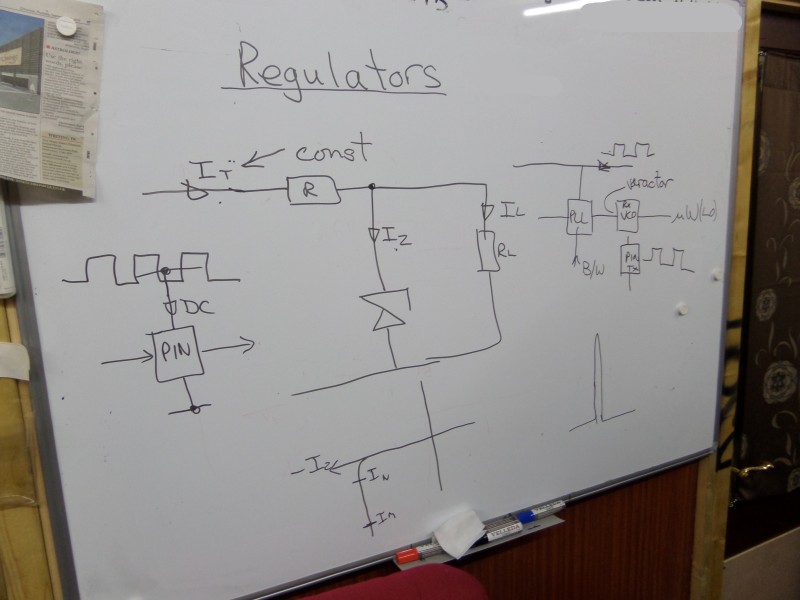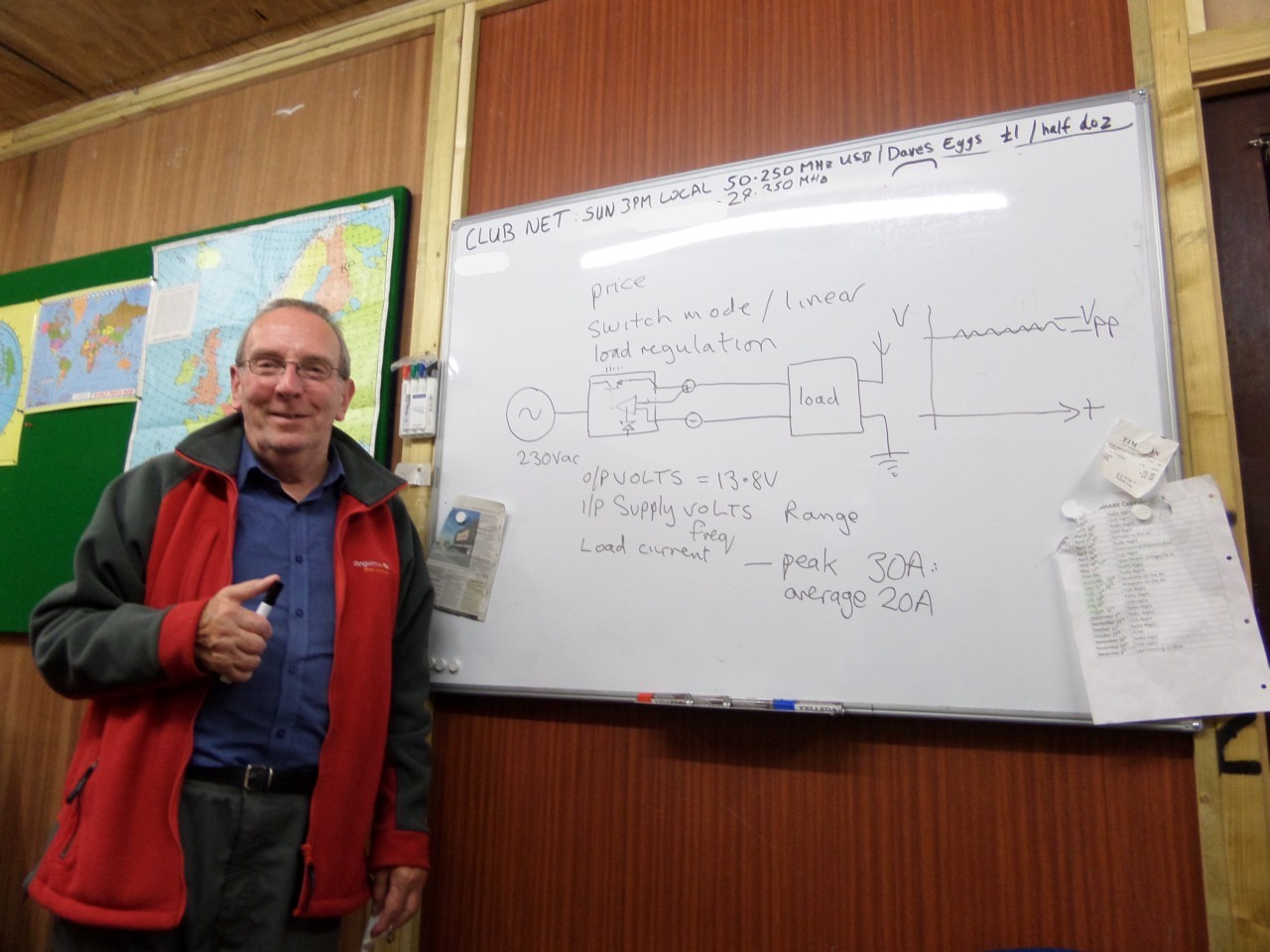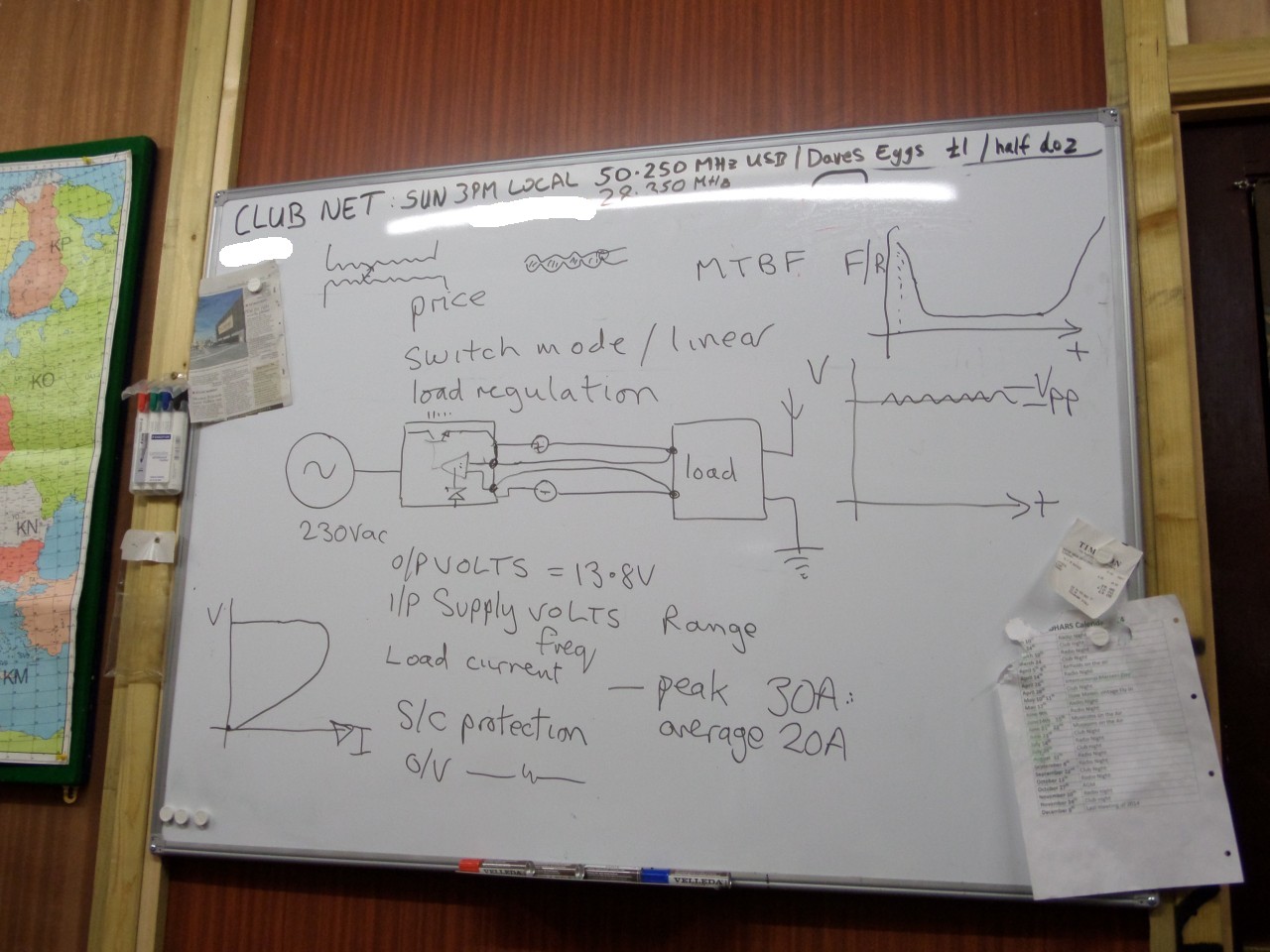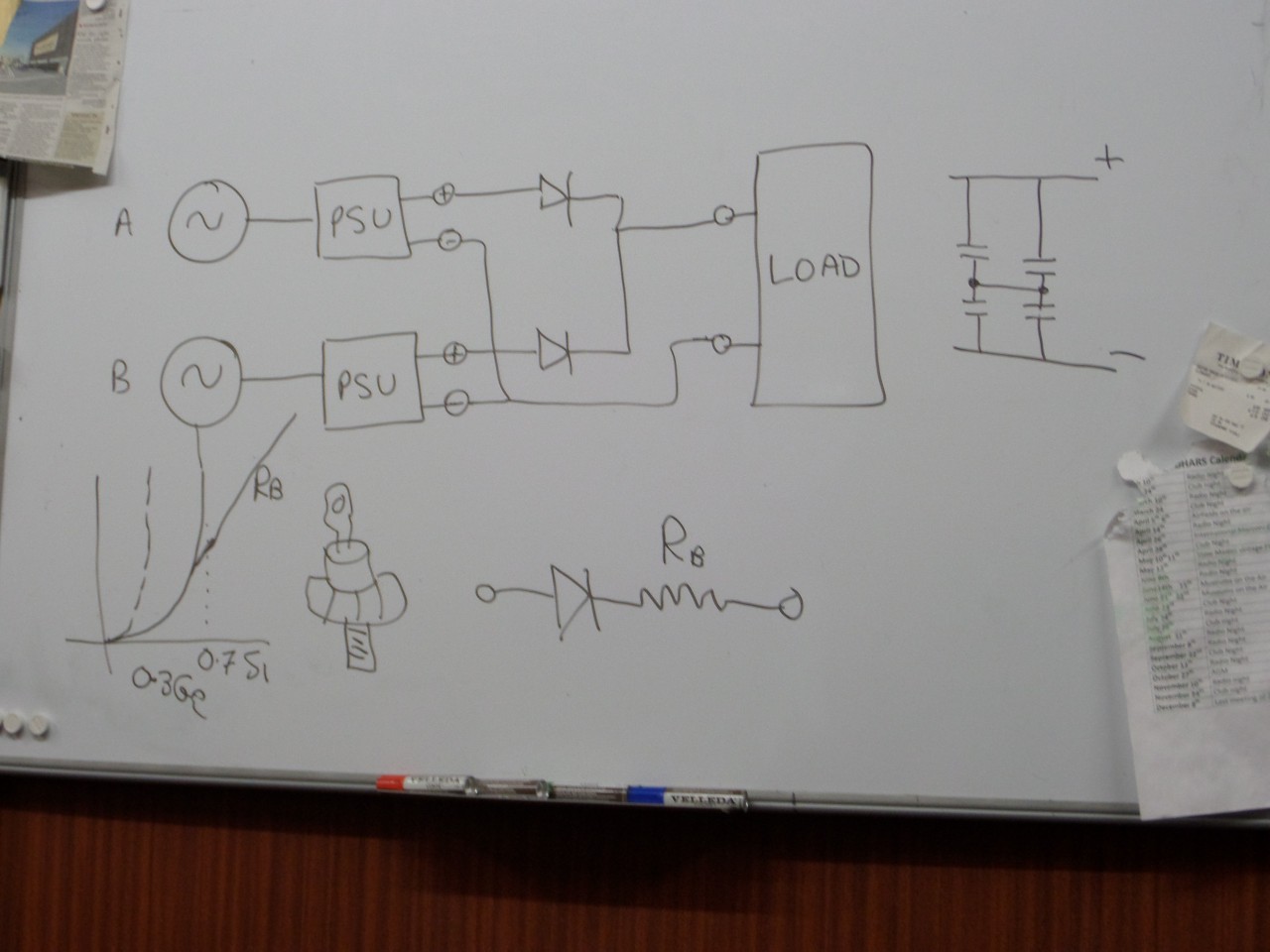
Maurce gave a talk and demonstration of the static electricity which can be generated so easily - with sellotape being one of the worst culprits. The subject of latent damage was discussed, where damage is caused to a part, which is not detectable when tested, but causes premature failure later.
Patrick gave a second in a multi-part series on DC power suppies. This time he concentrated on the shunt regulated power supply, where the current drawn from the power source (Psource)is constant. It is made up of two components.
At all times,Psource = Pload + Pinternal. This means there's the DC output from the power supply keeps a more stable voltage as the load current is changed, since despite changed in load current, the power used by the power supply is constant.

Patrick gave a talk about DC power supplies. Each member of the audience was asked to name one parameter for the specification of a DC power supply. The first person got had it easy, mentioning DC output voltage. Numerous parameters were discussed including
Although the talk was not aimed to show how to design power supplies, it was mentioned that large power supplies generate a lot of heat in the semiconductors, and that heatsinking them properly does not mean putting in lots of heat sink compound, but the bare minimum. There was quite a lot of audience participation.

The next photo shows how 4-wire sensing may be used to keep the voltage at a load constant, irrespective of the voltage drop across the cables feeding the load.

Pat showed how 4 decoupling capacitors may be used in a power supply in such a way that neither an open or short circuit failure of any one capacitor results in total loss of capacitance.

The society's AGM was held on Monday 13th October 2015. Minutes should have been circulated to all members.
Dr. David Kirkby (G8WRB) gave a talk about noise figure, with a particular emphasis on RF pre-amplifiers. David explained the concepts of noise figure, and demonstrated measuring the noise figure of two RF amplifiers with an HP 8970A noise figure meter. The two amplifiers used were both made by Minicircuits - one being designed for low noise operation, and the other high power. David explained that using the Y-factor method, which is the most common method of noise figure measurement, two different levels of noise are required. Although these can in principle be obtained from resistors immersed in liquids of different temperatures, which gives a calibrated results, in practice a semiconductor noise source is often preferable, as it just requires 28 V to switch the noise source on/off, which is a lot more convenient than using liquid nitrogen, ice or boiling water.
For accurate results, the connector on the noise source must mate directly to the connector at the input of the amplifier. This was not the case for the amplifiers used, so the results could not be expected to be very accurate, but these components were sufficient to illustrate the principle.
In the first figure, we see a Minicircuits ZHL-2-8 medium power amplifier being measured at 432 MHz. This amplifier was designed for use of powers up to 29 dBm (almost one Watt). Generally amplifiers designed for low noise have very low output powers, so one would not expect an amplifier of this power to be particularly low noise. The HP 8970A indicated a gain of 29.55 dB and noise figure of 6.38 dB. (Click the image for a higher resolution version.) This amplifier was designed for use of powers up to 29 dBm (almost one Watt).
In the next figure we see a Minicircuits ZFL-1000LN+, which has a significantly lower noise figure (3.23 dB), but is designed for much lower powers (2 mW) than the medium power amplifiers. Again, the gain and noise figures indicated on the HP 8970A noise figure meter should only be used as a guide, due to the fact the noise source did not have the right connector for the amplifier.
Don gave a talks about HF antennas. The emphasis was mainly on using wire antennas, which have several advantages over using beams at HF.
In addition to handing out some notes on HF antennas Don made use of the club's whiteboard to illustrate the points.
Don covered a wide range of antenna types including
There was various descriptions about methods to lower the radiation pattern of antennas, to work longer distances, as well as the construction of tuning units, using ferrite cores, variable capacitors and fixed inductors. Overall the talk was very well received.
Despite the title, there were no simulations shown from MMANA (now renamed MMANA-GAL), but the use of the MMANA-GAL software was covered in previous talk a couple of months earlier by Don.
"Dr. Dave", as he is known in the club, bought along a bench-top LCR meter, to show how electronic components don't always behave as you expect. For example, an inductor will become a capacitor above a certain frequency! The frequencies used for the demonstration were all below 1 MHz, showing that care is needed in the selection of components at even modest frequencies. David also showed how a standard diode may be used as a variable capacitor.
The Hewlett Packard 4284A precision LCR meter shown below (click image for a higher resolution version), was used for the demonstration.
The HP 4284A LCR meter covers the frequency range 20 Hz to 1 MHz. This was calibrated only a week earlier by Keysight, and given its basic uncertainty is 0.05 %, it is a much better than typical junk LCR meters from China, where random number generators are used to generate the specifications! David bought a number of fixtures for the LCR meter, including some he had made, and some made by HP, Agilent and Keysight. All have 4 BNC plugs, for a true 4-wire Kelvin connection to the LCR meter.
The first photograph shows 3 commercial fixtures for the LCR meter.
The next photograph shows a home-made fixture, which has two banana sockets with a standard 3/4" (19.05 mm) spacing, for connection to devices with banana plugs.
David
on top-band, and after getting answers showed that actually the self-capacitance of the 19 turns of 2.5 mm2 wire was making the antenna resonate at 320 kHz, so no amount of parallel capacitance would resonate the loop on top-band. The antenna was designed to pick up Loran-C signals at 100 kHz for a Stanford Research FS700 frequency standard. Since Loran-C signals spread over a large spectrum, so an antenna tuned for resonance at 100 kHz would not work.
Stephen bought along various antennas for 2m/70 cm, including one he had made, and one he had purchased. An attempt was made to contact the International Space Station, but was unfortunately unsuccessful.
Don, one of the club's antenna experts, gave a demonstration on the use of the free antenna analysis software MMANA-GAL for the analysis of HF antennas. Even though some other members of the club had used MMANA-GAL before, they too learned from Don's talk. You can find some plots Don produced with MMANA-GAL on his webpage about the HF Skeleton Slot antenna he developed.
The club entered the 24 hour 2 m contest, which started on Saturday and finished Sunday, being active for almost all of the 24 hours. Despite only having a 25 W transceiver on the day, we were placed third in our category, where other entrants would have had considerably more power. Unfortunately, although at a fixed site, we were in a /P division, as our license had not been changed to reflect our new address. Our license has since been updated to our new address
Graham demonstrated the Hunter Software defined radio (SDR) receiver he had built. Graham is working on the construction of a SDR transceiver, which he will no doubt demonstrate once it is completed.